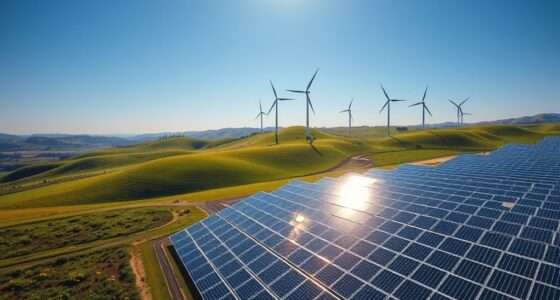By 2025, climate change accelerates, bringing critical tipping points closer—like sea level rise, extreme weather, and biodiversity loss—that could trigger irreversible environmental changes. If fossil fuel use remains high, crossing these thresholds becomes more likely, risking severe impacts on life and livelihoods. Urgent action is needed to curb emissions and adopt renewable energy. Keep exploring to understand which warning signs could signal we’re approaching these dangerous boundaries—and what it means for your future.
Key Takeaways
- Critical thresholds like sea level rise and ice sheet collapse may become irreversible if emissions aren’t curbed.
- Increased frequency of severe weather events could signal approaching climate tipping points.
- Biodiversity loss may accelerate as ecosystems reach ecological thresholds, risking collapse.
- Continued fossil fuel reliance heightens the risk of crossing dangerous climate thresholds.
- Effective policies and renewable energy scaling are vital to prevent crossing irreversible climate tipping points.

Have we truly made progress in tackling climate change by 2025? It’s a question many of us ask as we see global efforts accelerate and new technologies emerge. The answer isn’t straightforward, but the strides made in renewable energy and efforts to reduce carbon emissions are undeniable. Over the past few years, investments in renewable energy sources like solar, wind, and hydro have surged. You’ve likely noticed more solar panels on rooftops and wind farms stretching across landscapes. These initiatives are vital because renewable energy helps replace fossil fuels, which are major contributors to carbon emissions. By shifting to cleaner energy sources, countries aim to cut down their greenhouse gases, slow global warming, and meet climate targets.
Renewable energy investments surge as countries aim to cut greenhouse gases and combat climate change.
However, progress isn’t uniform everywhere. Some regions still depend heavily on coal and oil, making it harder to curb emissions. You might see that in areas where renewable energy infrastructure is less developed or where political and economic challenges hinder transition efforts. Despite these setbacks, the global community has recognized the urgent need to reduce carbon emissions to avoid crossing critical climate tipping points. This has led to international agreements and national policies focused on setting stricter emissions targets and promoting renewable energy investments.
In recent years, technological advances have played a pivotal role. Cheaper solar panels and more efficient wind turbines mean you now have better access to renewable energy options. This not only helps households reduce their carbon footprint but also encourages industries to adopt greener practices. Yet, even with these innovations, the challenge remains to accelerate adoption at a scale that truly impacts global emissions. You might wonder if these measures are enough to meet the 2025 climate goals, and the truth is, it’s a mixed picture. Some countries are making significant progress, while others lag behind due to economic or political hurdles.
The urgency to curb carbon emissions is driven by the understanding that continued reliance on fossil fuels will push the climate toward irreversible tipping points. These include catastrophic sea level rise, severe weather events, and loss of biodiversity. Every ton of carbon dioxide emitted today pushes us closer to these dangerous thresholds. That’s why the push for renewable energy isn’t just about cleaner power; it’s about safeguarding the stability of Earth’s climate system. As you look ahead, the real question is whether the investments and policies enacted so far will be enough to keep us from crossing those critical tipping points. The stakes couldn’t be higher.
Frequently Asked Questions
How Will Climate Migration Impact Global Economies by 2025?
You’ll see climate migration cause significant economic destabilization by 2025, as increasing climate refugees strain resources and infrastructure. This surge in displaced people can lead to labor shortages in some regions while overburdening social services elsewhere. The resulting instability may disrupt markets and global trade, forcing governments to allocate more funds for emergency responses. Overall, climate migration will challenge economic resilience and require coordinated international efforts to manage its impacts effectively.
What Technological Innovations Are Most Promising for Climate Mitigation?
You should focus on renewable energy innovations like advanced solar panels and wind turbines, which can drastically cut emissions. Additionally, carbon capture technology offers promising solutions by removing CO2 directly from the atmosphere or industrial sources. These innovations are vital for effective climate mitigation, helping you reduce your carbon footprint and support a sustainable future. Embracing these technologies accelerates global efforts to combat climate change and stay within safe planetary boundaries.
How Will Climate Change Affect Biodiversity Hotspots Specifically?
You’ll see climate change intensify threats to biodiversity hotspots through increased habitat loss and species extinction. Rising temperatures and changing rainfall patterns damage vital ecosystems, making it harder for species to survive. As habitats shrink or degrade, you’ll notice a decline in species diversity, pushing many toward extinction. Protecting these areas becomes urgent, as failure to act accelerates biodiversity loss, threatening the global ecological balance.
What Role Will Policy Changes Play in Preventing Crossing Tipping Points?
If you want to avoid catastrophic climate tipping points, policy changes will be your game-changer. Your actions can dramatically influence policy impact, steering prevention strategies toward success. Strong policies can curb emissions, protect ecosystems, and promote sustainable practices. Without swift policy shifts, we risk crossing irreversible thresholds. You have the power to push for bold policies, ensuring a safer, more resilient future rather than facing irreversible climate chaos.
How Can Individuals Contribute Effectively to Climate Resilience Efforts?
You can contribute effectively to climate resilience efforts by taking individual actions like reducing your energy use, supporting renewable energy, and minimizing waste. Get involved in community resilience initiatives, such as local clean-up events or tree planting projects. Spreading awareness and encouraging others to act amplifies your impact. Every small step counts toward strengthening community resilience and building a sustainable future, so stay proactive and committed to positive change.
Conclusion
By 2025, the tipping points you face are like a delicate field of dominoes ready to fall. Your actions can either keep the chain from toppling or set off a cascade of irreversible change. Stay informed, advocate for sustainable choices, and act now—because the future of our planet depends on your willingness to hold the line. Remember, you’re the gardener tending to this fragile garden, and it’s up to you to protect its future.










